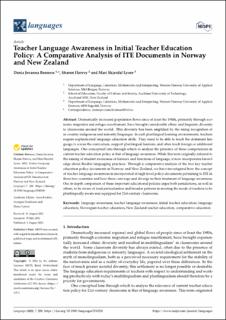| dc.description.abstract | Dramatically increased population flows since at least the 1980s, primarily through economic migration and refugee resettlement, have brought considerable ethnic and linguistic diversity to classrooms around the world. This diversity has been amplified by the rising recognition of in-country indigenous and minority languages. In such plurilingual learning environments, teachers require sophisticated language education skills. They need to be able to teach the dominant language/s across the curriculum, support plurilingual learners, and often teach foreign or additional languages. One conceptual lens through which to analyse the presence of these competencies in current teacher education policy is that of language awareness. While this term originally referred to the raising of student awareness of features and functions of language, it now incorporates knowledge about flexible languaging practices. Through a comparative analysis of the two key teacher education policy documents in Norway and New Zealand, we have investigated how the concept of teacher language awareness is incorporated in high-level policy documents pertaining to ITE in these two countries and how these converge and diverge in their treatment of language awareness. Our in-depth comparison of these important educational policies urges both jurisdictions, as well as others, to be aware of local particularities and broader patterns in meeting the needs of teachers to be plurilingually aware and equipped for 21st-century classrooms. | en_US |

